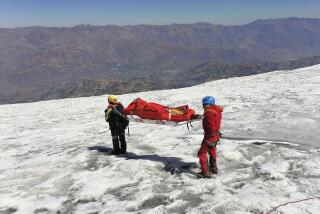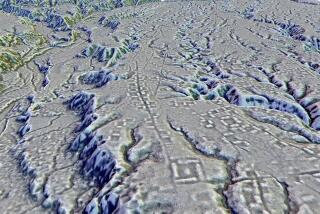Late Inca Outpost Is Found in Peru
- Share via
Deep in an inaccessible canyon in the remotest area of Peru, a British-American team has discovered what appears to be one of the last refuges of the Incas before their civilization was destroyed by the Spanish in 1572.
Tipped off to the site’s location by a native mule handler, the team hacked through dense forest with machetes for a week before finally descending 6,000 feet into a gorge on the Yanama river and encountering the jungle-shrouded city.
The site, called Cota Coca, is the second Inca settlement whose discovery has been announced in the last two months. In March, a National Geographic Society team revealed the discovery of a mountaintop settlement at Cerro Victoria. The new site is twice as large, however, and much better preserved.
Cota Coca, whose discovery was revealed Thursday by Britain’s Royal Geographical Society, might have served as one of the homes of the Inca rulers from 1532, when Manco Inca led a rebellion against the Spanish conquerors, until 1572, when the last Inca ruler, Tupac Amaru, was executed.
It could have been a key outpost in the guerrilla warfare conducted against the Spanish during that period, said British archeologist Hugh Thomson, a fellow of the royal society, who led the expedition with American archeologist Gary Ziegler. “It would have served as a jumping-off point from which they could have harassed the Spanish traveling on the royal road between Cuzco and Lima,” he said.
Finding the site was a “once-in-a-lifetime experience,” Thomson said. “With so much of the world discovered and mapped, it’s reassuring to feel that there are still places that we don’t know about.”
“This is probably the most exciting thing I have ever found,” said Ziegler of Colorado, who finances his explorations by organizing archeology-based tours to Peru. Both of the expedition leaders are experienced Inca experts who have been working in Peru for at least two decades.
Cota Coca is located at an altitude of about 6,000 feet near the junction of the Yanama and Blanco rivers in the rugged Vilcabamba region of eastern Peru, about 100 miles west of the Inca capital, Cuzco. It is on an isolated bench, or mesa, about 1.5 miles long, carved out by the Rio Yanama in its mad rush to join the Rio Blanco.
Evidence from the site suggests that the Incas built a road linking Cota Coca to the former capital of Choquiquirao, only a few miles downriver. A road in the opposite direction led toward Vitcos, a secondary Inca city.
The Incas built an extensive network of such roads, as many as 24,000 miles’ worth. The roads were up to 14 feet wide and, when conditions permitted, were paved with flat, fitted stones and retained by stone walls.
Most of the road between Cota Coca and the two nearby cities was washed away by the Yanama river, however, and what remains is hidden by dense overgrowth.
“The reason no one has ever found this site before is that it lies at the bottom of a very deep valley,” Thomson said. “The river has eroded the valley wall so badly that the valley is no longer passable--you can’t go up and down the valley. The only way to get there is to descend directly from the mountain above.”
The site “is sort of a missing piece of a jigsaw puzzle,” he said. “We knew there had to be roads leading into and out of this area, and a road leading through to the Rio Apurimac. This ruin rather neatly fitted the jigsaw. It’s very much the missing piece.”
The team, which also included veteran British archeologist Nicholas Asheshov and Australian explorer John Leivers, spent nearly a week hacking away the brush from the city.
Under the brush, they found more than 30 stone buildings, including a 75-foot-long kallanka, or meeting house, grouped around a central plaza. Outside the central area are more well-made rectangular houses.
Two large walled enclosures, each about 100 by 175 feet, might have been pens for passing llama convoys.
“This is an important discovery because it is a sizable center of good-quality, late-Inca masonry,” said John Hemming, a former director of the royal society.
Before it served as a possible refuge for Manco Inca and his followers, Cota Coca was probably a regional administrative center and way station for high-ranking travelers, Thomson said. In general, the layout is functional rather than ceremonial.
Some buildings in the outlying sectors might have housed resident administrators, record keepers, workers and servants living and working at such an outpost, he added. The sizable number of closely grouped round and oval structures might have been lodging for workers and storehouses for corn and other commodities.
“What was remarkable was that the site was completely unlooted when we arrived,” Thomson said. “That’s very, very rare in Peru. We could see on the surface that it was untouched. Normally, at a site like this there are huge holes everywhere where the looters have been.”
The team did not do any excavations to look for artifacts. “That would have been irresponsible,” Thomson said. The team did find a few grinding stones on the surface and some pottery shards.
“These things have to be done like a lightning strike--get in, clear the site and map it,” he said. Careful excavation will be left to a future expedition, either by the team or others. For the moment, the area is being protected by the government to prevent looting.
Thomson noted that “few of the Inca settlements in the area have been properly excavated. What is remarkable is how little we still know about the Incas compared to most of the other ancient civilizations, not only the Egyptians and the Greeks, but even the Maya and the Aztecs.
“Part of that is because they lacked writing, but it is also because less work has been done on them. It feels to me as if we are still on the cutting edge of making new discoveries about their civilization.” A report on the expedition is on the society’s Web site at www.rgs.org.
More to Read
Sign up for Essential California
The most important California stories and recommendations in your inbox every morning.
You may occasionally receive promotional content from the Los Angeles Times.










